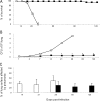Using a label-free proteomics method to identify differentially abundant proteins in closely related hypo- and hypervirulent clinical Mycobacterium tuberculosis Beijing isolates
- PMID: 20190197
- PMCID: PMC2984234
- DOI: 10.1074/mcp.M900422-MCP200
Using a label-free proteomics method to identify differentially abundant proteins in closely related hypo- and hypervirulent clinical Mycobacterium tuberculosis Beijing isolates
Abstract
Although the genome of the Mycobacterium tuberculosis H37Rv laboratory strain has been available for over 10 years, it is only recently that genomic information from clinical isolates has been used to generate the hypothesis of virulence differences between different strains. In addition, the relationship between strains displaying differing virulence in an epidemiological setting and their behavior in animal models has received little attention. The potential causes for variation in virulence between strains, as determined by differential protein expression, have similarly been a neglected area of investigation. In this study, we used a label-free quantitative proteomics approach to estimate differences in protein abundance between two closely related Beijing genotypes that have been shown to be hyper- and hypovirulent on the basis of both epidemiological and mouse model studies. We were able to identify a total of 1668 proteins from both samples, and protein abundance calculations revealed that 48 proteins were over-represented in the hypovirulent isolate, whereas 53 were over-represented in the hypervirulent. Functional classification of these results shows that molecules of cell wall organization and DNA transcription regulatory proteins may have a critical influence in defining the level of virulence. The reduction in the presence of ESAT-6, other Esx-like proteins, and FbpD (MPT51) in the hypervirulent strain indicates that changes in the repertoire of highly immunogenic proteins can be a defensive process undertaken by the virulent cell. In addition, most of the previously well characterized gene targets related to virulence were found to be similarly expressed in our model. Our data support the use of proteomics as a complementary tool for genomic comparisons to understand the biology of M. tuberculosis virulence.
Figures





Similar articles
-
Comparison of membrane proteins of Mycobacterium tuberculosis H37Rv and H37Ra strains.BMC Microbiol. 2011 Jan 24;11:18. doi: 10.1186/1471-2180-11-18. BMC Microbiol. 2011. PMID: 21261938 Free PMC article.
-
Secretome profile analysis of hypervirulent Mycobacterium tuberculosis CPT31 reveals increased production of EsxB and proteins involved in adaptation to intracellular lifestyle.Pathog Dis. 2016 Mar;74(2):ftv127. doi: 10.1093/femspd/ftv127. Epub 2016 Jan 4. Pathog Dis. 2016. PMID: 26733498
-
Mutations in ppe38 block PE_PGRS secretion and increase virulence of Mycobacterium tuberculosis.Nat Microbiol. 2018 Feb;3(2):181-188. doi: 10.1038/s41564-017-0090-6. Epub 2018 Jan 15. Nat Microbiol. 2018. PMID: 29335553
-
Limitations of the Mycobacterium tuberculosis reference genome H37Rv in the detection of virulence-related loci.Genomics. 2017 Oct;109(5-6):471-474. doi: 10.1016/j.ygeno.2017.07.004. Epub 2017 Jul 22. Genomics. 2017. PMID: 28743540 Review.
-
The clinical consequences of strain diversity in Mycobacterium tuberculosis.Trans R Soc Trop Med Hyg. 2008 Oct;102(10):955-65. doi: 10.1016/j.trstmh.2008.03.025. Epub 2008 May 29. Trans R Soc Trop Med Hyg. 2008. PMID: 18513773 Review.
Cited by
-
The genetic proteome: Using genetics to inform the proteome of mycobacterial pathogens.PLoS Pathog. 2021 Jan 7;17(1):e1009124. doi: 10.1371/journal.ppat.1009124. eCollection 2021 Jan. PLoS Pathog. 2021. PMID: 33411813 Free PMC article. Review.
-
RNAseq reveals hypervirulence-specific host responses to M. tuberculosis infection.Virulence. 2017 Aug 18;8(6):848-858. doi: 10.1080/21505594.2016.1250994. Epub 2016 Oct 20. Virulence. 2017. PMID: 27763806 Free PMC article.
-
Mycobacterium tuberculosis sensor kinase DosS modulates the autophagosome in a DosR-independent manner.Commun Biol. 2019 Sep 20;2:349. doi: 10.1038/s42003-019-0594-0. eCollection 2019. Commun Biol. 2019. PMID: 31552302 Free PMC article.
-
Mycobacterium tuberculosis CysA2 is a dual sulfurtransferase with activity against thiosulfate and 3-mercaptopyruvate and interacts with mammalian cells.Sci Rep. 2019 Nov 14;9(1):16791. doi: 10.1038/s41598-019-53069-6. Sci Rep. 2019. PMID: 31727914 Free PMC article.
-
Pomacea canaliculata Ampullar Proteome: A Nematode-Based Bio-Pesticide Induces Changes in Metabolic and Stress-Related Pathways.Biology (Basel). 2021 Oct 15;10(10):1049. doi: 10.3390/biology10101049. Biology (Basel). 2021. PMID: 34681148 Free PMC article.
References
-
- Dormans J., Burger M., Aguilar D., Hernandez-Pando R., Kremer K., Roholl P., Arend S. M., van Soolingen D. (2004) Correlation of virulence, lung pathology, bacterial load and delayed type hypersensitivity responses after infection with different Mycobacterium tuberculosis genotypes in a BALB/c mouse model. Clin. Exp. Immunol. 137, 460–468 - PMC - PubMed
-
- Manca C., Tsenova L., Bergtold A., Freeman S., Tovey M., Musser J. M., Barry C. E., 3rd, Freedman V. H., Kaplan G. (2001) Virulence of a Mycobacterium tuberculosis clinical isolate in mice is determined by failure to induce Th1 type immunity and is associated with induction of IFN-alpha/beta. Proc. Natl. Acad. Sci. U.S.A. 98, 5752–5757 - PMC - PubMed
Publication types
MeSH terms
Substances
LinkOut - more resources
Full Text Sources
Medical

